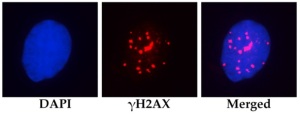by
John R. Fischer, Senior Reporter | January 02, 2018

Biophysicists have found that low-
dose radiation exposure does not cause
aging or death in stem cells
Exposure to low-dose X-rays poses no harm to stem cells, a find that could be important for assessing patients undergoing stem cell therapy and diagnostic X-ray exams simultaneously.
That’s according to Russian biophysicists from the Moscow Institute of Physics and Technology, who claim that stem cells remain healthy, proliferate and do not accumulate damage to human DNA that could be passed down to their progeny when exposed to low-dose X-rays. Their findings were published as a paper in the journal, “Aging”.
"Computed tomography scans, delivering doses between 5 and 80 milligrays (mGy) to patients, depending on the type of scan and the portion of the body involved, are the main means of follow-up examination for patients receiving stem cell transplants to monitor the results of the transplantation (proper homing to the targeted tissue) or potential complications and side effects," Andreyan Osipov, professor at the Russian Academy of Sciences and the head of the Experimental Radiobiology and Radiation Medicine Department at the Federal Medical Biophysical Center, and one of the authors of the paper, told HCB News. "With the growing number of stem cell therapies and the diseases they target (hundreds of clinical trials in progress), the number of patients receiving both stem cell transplants and low doses of X-rays will increase."



Ad Statistics
Times Displayed: 656
Times Visited: 5 Fast-moving cardiac structures have a big impact on imaging. Fujifilm’s SCENARIA View premium performance CT brings solutions to address motion in Coronary CTA while delivering unique dose saving and workflow increasing benefits.
Ionizing radiation from medical diagnostic procedures, such as CT scans and mammograms, supposedly causes damage in stem cells that can be passed on to their progeny and lead to cell death, accelerated cellular aging and malignant transformations. This, however, has only been observed extensively in larger-dose exposure, compared to low-dose, which is defined as 100 mGy.
One crucial example of damage that worries researchers is double-strand breaks in DNA which can take long to repair, with uncorrected breaks possibly leading to cytogenetic abnormalities, tumor suppressor gene inactivation, oncogene activation and cell death.
Researchers conducted a series of experiments on the delayed effects of low-dose radiation exposure. Following 24 hours of exposure to X-ray radiation, stem cells were found to consist of more yH2AX foci, a protein used as a damage marker in DNA, compared to ones exposed to an intermediate dose.
The increased accumulation of yH2AX foci, however, was only found in cells undergoing division, rather than quiescent cells, making double strand breaks natural rather than the product of low-dose radiation exposure. Such breaks can be repaired through homologous recombination, a slow but virtually error-free way of restoring lost genetic information in damaged DNA sequences.

